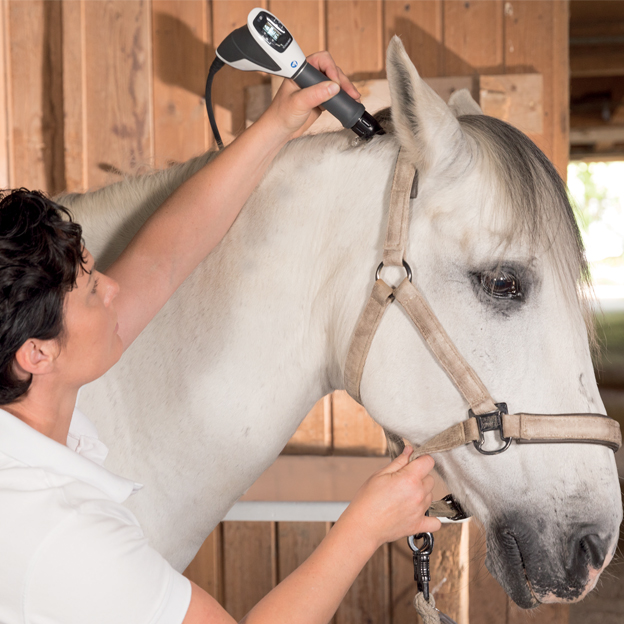Why Equine Therapy is Coming To Be a Preferred Choice for Emotional Health
Why Equine Therapy is Coming To Be a Preferred Choice for Emotional Health
Blog Article
Reviewing the Effectiveness of Laser Treatment in Horse Therapy for Injury Recovery
The examination of laser treatment's effectiveness in equine injury rehabilitation pivots on numerous factors, consisting of healing time, discomfort mitigation, and cells regeneration. Vets frequently observe premium outcomes with laser therapy compared to traditional methods, positioning it as a crucial element in equine care.
Comprehending Laser Therapy
Laser therapy has actually ended up being a pivotal device in vet medicine, especially in the treatment of equine conditions. Understood for its non-invasive nature and efficacy, laser therapy involves the application of particular wavelengths of light to stimulate cells repair service and minimize inflammation. This therapeutic modality is increasingly favored for its ability to accelerate the healing process in horses enduring from a range of bone and joint injuries and chronic problems.
The key mechanism behind laser therapy is its ability to boost mobile features. Additionally, laser treatment advertises vasodilation, boosting blood flow and oxygen shipment to damaged tissues, thus accelerating healing.
In equine medication, laser therapy is specifically helpful for conditions such as tendonitis, osteo arthritis, and injury recovery. The method is admired for its pain-relieving properties, permitting horses to regain movement and feature extra rapidly. Veterinarians likewise appreciate its minimal side impacts compared to various other therapy techniques, making it a trustworthy and risk-free choice for equine care.

How Laser Therapy Functions

Upon absorption, these photons cause a series of biochemical modifications, improving mitochondrial function and causing boosted adenosine triphosphate (ATP) production. This surge in ATP speeds up cellular metabolic rate, advertising cells repair work and regeneration. Additionally, laser treatment regulates inflammatory actions by impacting cytokine degrees and minimizing oxidative anxiety, therefore easing pain and swelling.
One more significant aspect of laser therapy is its duty in improving microcirculation. The treatment advertises vasodilation, improving blood circulation and oxygen delivery to broken tissues (Equine Therapy). This facilitates the elimination of cellular debris and supports the proliferation of fibroblasts and collagen synthesis, important for wound recovery
Clinical Proof
The efficacy of laser treatment in equine treatment has actually been validated with various professional researches, showcasing its therapeutic prospective throughout a range of problems. A number of regulated tests and observational studies have actually documented significant improvements in cells repair, pain reduction, and overall rehabilitation timelines. A study carried out by Turner et al. (2012) demonstrated that equines treated with low-level laser therapy (LLLT) for ligament injuries exhibited sped up healing compared to those receiving traditional treatments. The research highlighted a significant reduction in inflammation and boosted collagen development.
In a similar way, research click here for more info study by Johnson and associates (2015) concentrated on equine muscle mass injuries, exposing that laser therapy dramatically expedited muscular tissue fiber regeneration and reduced muscle rigidity. These searchings for were supported by histological analyses showing enhanced muscle cells organization. In addition, professional analyses have actually shown that laser treatment can reduce persistent problems such as osteo arthritis. A research by Smith et al. (2018) reported that steeds with osteoarthritic joints experienced notable pain alleviation and enhanced range of movement adhering to a program of laser therapy sessions.
Vet Insights

Veterinarians additionally value the convenience of laser treatment. It can be utilized for a vast array of problems, from surface injuries to read what he said deeper musculoskeletal injuries. Dr. Emily Brown highlights its energy in treating problems like tendonitis and osteo arthritis, where traditional therapies typically fail. She mentions that laser treatment can be customized to the particular needs of each steed, guaranteeing optimal end results.
Additionally, vets value the capacity to incorporate laser therapy with various other treatment methods. This multimodal method can boost total treatment efficacy, supplying a comprehensive service for equine rehabilitation. Such endorsements from skilled experts highlight the growing acceptance and application of laser therapy in equine medication.
Practical Factors To Consider
A vital facet of implementing laser therapy in equine treatment involves recognizing the useful factors to consider that ensure its effectiveness and safety and security. Most importantly, it is vital to choose the suitable laser device, as various types more info here vary in wavelength, power, and infiltration depth. Equine Therapy. Veterinarians must be well-versed in these specifications to tailor therapy procedures efficiently per injury kind
Moreover, the frequency and period of laser treatment sessions need mindful planning to maximize healing advantages while lessening any type of potential negative effects. Consistent tracking of the horse's response to therapy can lead required changes in the therapy regimen. Establishing a risk-free and regulated environment throughout therapies is likewise important to avoid accidental exposure to laser emissions, which can damage both the steed and the handler.
Educating and accreditation of personnel carrying out laser treatment are extremely important to ensure correct method and to copyright security requirements. Furthermore, maintaining exact documents of each session, including laser setups and observed results, is important for evaluating the total performance of the therapy and for making data-driven decisions.
Verdict
Laser treatment has emerged as an efficient technique in equine injury rehab, providing significant benefits in recuperation time, pain relief, and tissue healing. For optimal results, constant surveillance and individualized treatment procedures continue to be crucial in leveraging the full capacity of laser therapy in equine treatment.
Report this page